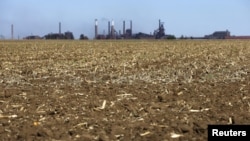A severe drought along with a scorching heat wave are hitting South Africa’s agricultural sector as the region braces for more fallout from El Niño.
Weather experts describe the drought as South Africa’s worst in 23 years. And they blame El Niño, a global climate phenomenon characterized by the warming of ocean surface temperatures in equatorial parts of the Pacific every few years.
Meterologists said El Niño will lead to drought and flooding in parts of east and southern Africa this year.
South Africa has already experienced two seasons of below-normal rainfall.
Higher temperatures
Francois Engelbrecht, researcher at the Council for Scientific and Industrial Research (CSIR), said this year would be no better.
“We have seen temperature records being broken this year and El Niño events are usually associated with below-normal rainfall during our midsummer period. Now that is still to come. That is the period December to February,” Engelbrecht said.
As a result, farmers are now expected to plant only 2.5 million hectares of maize, a 3.8 percent reduction from last year.
Reduced crop yields and animal production, as well as interest on bank loans, will cause farmers to lose an estimated $700 million.
Farmers, consumers affected
Agricultural Economist Wandile Sihlobo said the crisis will also hit consumers.
“The impact is there. You are looking at maize prices now. They are around 67 percent higher than they were last year, and the yellow maize 45 percent higher than they were last year," Sihlobo said. "So all of this is going to start to filter through and people are going to start to find food products at higher prices."
The South African government has declared the provinces of Kwazulu Natal and Free State as disaster areas due to water shortages.
Authorities are expected to declare two more areas -- Limpopo and Mpumalanga -- agricultural disaster areas soon. The declaration empowers the national government to intervene.
The government has set aside more than $25 million to deal with the water shortages. This includes sending mobile water tankers to affected communities and drilling boreholes.








